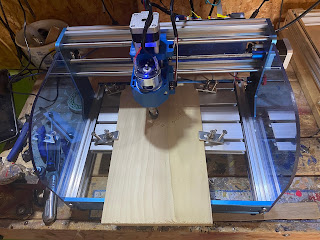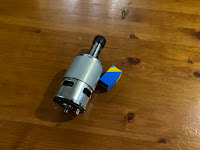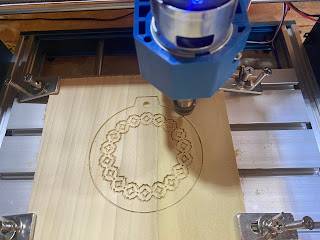A couple of years ago I bought myself a pretty cheap CNC router off of Amazon, mainly just to experiment and learn how to use one in my woodworking projects.
The router that I had bought was a very cheap one based on the very common 3018 router platform, which uses an Arduino as its brain and uses the GCODE language as its instruction set. It was a very basic router and I could tell that it was certainly made on the cheap since a lot of the plastic parts, particularly the spindle motor mount was made from a 3D printer - so it wasn't necessarily made to precise tolerances. But for a learning machine, I figured it would be a good one to start with,
This cheapness evidently came across when I tried to use it. Since the mount had a little bit of play in it, the bits were prone to chatter, which caused the carving to not always come out precisely, and with the added vibration from the chatter, the mounting screws and guide rails on the router tended to work themselves loose, which made tightening screws and securing guides in place with a little bit of hot glue a common maintenance procedure.
In its defense, I was also learning how to use the tool, and as a result, I know I had subjected it to a fair bit of abuse since I made a lot of rookie mistakes in learning how to program it. The most common mistake was taking too deep of a cut while moving the bit too fast, which did put a lot of stress on the spindle mount. I learned that slow, shallow cuts were the key to success. Plus, all the little repairs that I was doing gave me a better appreciation of how these machines are constructed.
At the time, I didn't realize that that cheap little router was the start in my journey in creating things with the help of computer-assisted tools because my fascination with this router spurred me on to buying a laser engraver and a 3D printer, two tools that I use almost constantly today.
A sad fact of life however is that sometimes it's just simply not worth it to fix something after a certain point in time, be it an old car, or an old CNC router. Last week a set screw fell out of the Z shaft of the router, which caused the bit to drop deep into the wood piece that I was working on and the router was trying its best to set the wood on fire with friction when I peeked in on it. At that point, I figured it was time to move on to a better machine.
I still wanted to keep with the 3018 platforms since I now had a pretty good understanding of how they worked and I was now pretty familiar with their mechanical parts. Additionally, they also have a pretty good online community for support questions.
Also, I figured that since there are a lot of common parts between all the various flavors of the 3018, I figured that I can still use my old router as a source of any replacement parts that I may need.
However, I wanted to get something that was a bit more ruggedly constructed. After reading some reviews online I found that the 3018 routers produced by Genmitsu/Sainsmart were the most consistently recommended in any of the reviews that I read.
One particular 3018 based router that Sainsmart had on offer was a brand new one that was introduced last year - the 3018-PROVer, which was specially designed for prototyping and small production batches.
What appealed to me about the PROVer was that for the money it had a lot of high-end features such as an offline control unit, emergency shut-off switch, and limit switches that would shut down the machine if it goes beyond certain operating limits.
The reviews indicated that the machine was also more heavily built than the 3018-Pro, making it less susceptible to vibration issues.
Making that my choice, I placed my order and a couple of days later, the box showed up at my front door.
Opening up the box and taking out the parts, I was pretty impressed with the overall quality. The spindle mount in particular was made from a molded piece of plastic (not 3D printed!) with no looseness on the guide rails.
The enclosed tools and small parts were also well organized and of really good quality. I was particularly impressed that the supplied hold-down clamps were made from solid metal and secured the workpiece to the router table very well - this was a far cry from the laser cut plexiglass clamps that I got with my last router, which tended to get loose during a job.
Assembly was pretty straightforward, thanks to a well-written manual that was supplied and I was able to get it all assembled fairly quickly
Once I had it all assembled, I clamped a 1/2 inch thick piece of popular onto the bed of the router and I loaded up a GCODE program of a Christmas ornament that I wanted to try making and I put the router through its paces.
Immediately I noticed a huge difference in the quality of the cuts that the router was making on the wood. The cuts were far cleaner than I had with my old router, mainly because I no longer had the bit chattering issues with this router. Also with the additional heft built into the machine, I found the vibrations much reduced from the old machine.
My intent is to use the router to make a few sets of Christmas ornaments, so I plan on using this router quite extensively over the next few months. I will plan to provide a bit of an update on how it's holding up in a few months.










No comments:
Post a Comment